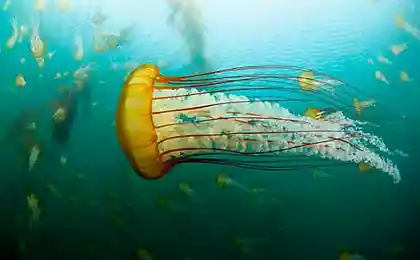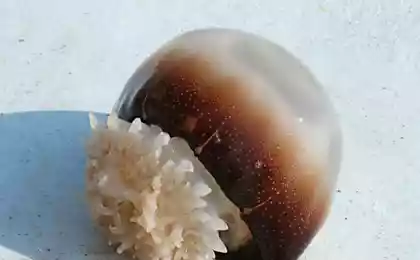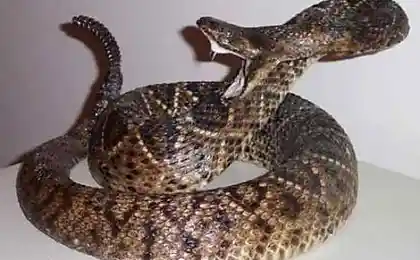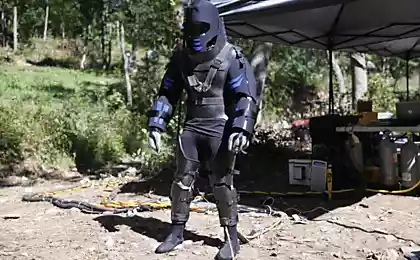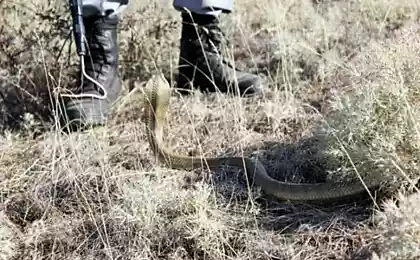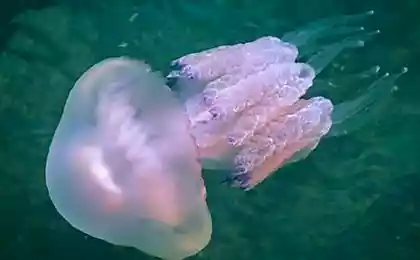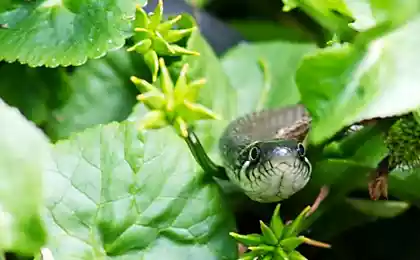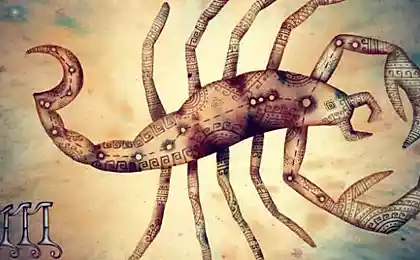773
Why do some animals have superadam
We've all heard stories about how snakes, jellyfish and Scorpions can kill a man. But why are these predatory animals have such a powerful poison when their typical sacrifices much less of a man?
My dreamy mood while walking through the beautiful Costa Rican national Park, Corcovado came to an abrupt end when the tour guide pushed a hand into my chest.
"Wait!", he shouted, pointing to something actively moving under the sand. "It's a sea serpent."
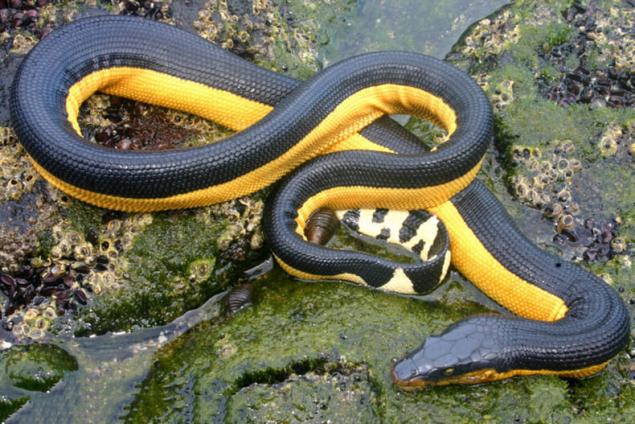
(Yellow-bellied sea snake, also known as the Pelamis platurus)
While I was watching yellow-bellied sea snake outside its native element, and obviously troubled, I remembered the fact which is learned in childhood. "Sea snake," he reminded me of my young I, " "the most dangerous of all snakes. You should be careful." .
In principle, it is true, many sea snakes and terrestrial snakes for that matter, is incredibly poisonous. In one bite Taipan snake has enough venom to kill 250,000 mice or 100 people. And this is true not only for snakes.
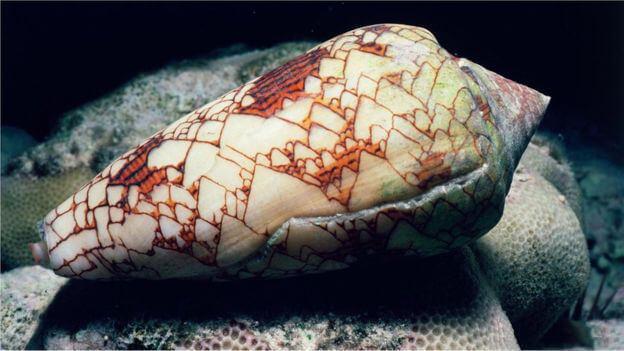
(Clam-cone)
One drop of poison of a mollusc cone marmoreus can kill 20 people. Jellyfish sting can cause cardiac arrest and death in a matter of minutes. This begs the question: why have a powerful weapon, capable of killing dozens of people, if you're going to use it only tete-a-tete, especially if your quarry will be on the much smaller man? It seems that supriyadi just don't make sense from an evolutionary point of view.
The reason animals have poisonous weapons in its Arsenal, is quite simple. The poison allows the predator to weaken/kill the victim, thus helping to avoid excessive risk caused by the protracted struggle with the victim. Poison is also useful for defense. However, it is surprising excessive toxicity to some organisms. Why can a snake be able to kill hundreds of thousands of mice in one bite? It looks especially strange when you consider that the poison — weapons are expensive.
Poisons usually contain a mixture of toxins are protein-based, often working as a team in order to damage internal organs being attacked. Genotoxicity snake venom can contain a single component that prevents the clotting of blood, and another component, which destroys the walls of blood vessels. The result of the action of the poison a bit predictable.
The synthesis of proteins requires considerable energy, but it did not stop the evolution of venoms contain thousands of peptides and proteins, even at great cost to the animals using them. And to some extent they themselves are aware of the price of their poison.
Such things are difficult to test directly, however, it seems that the snake is able to regulate the amount of venom injected depending on the size of their victims, so as not to waste precious venom hurl. Moreover, an experiment conducted on a rattling snakes showed 11% increase in metabolism, thereby demonstrating a link between physical strain and produce toxins.
The classical view on natural selection says that the "expensive" genes are discarded if they are not absolutely necessary for survival. And is the drop really happened in some species: so marble sea snake (Aipysurus eydouxii) after the transition to eating fish eggs have lost the ability to produce poison.
However, the fact remains that there are many animals with expensive "cocktails" of chemicals in the fangs, stings and thorns, which are much more powerful than they, apparently, need to survive. Why?
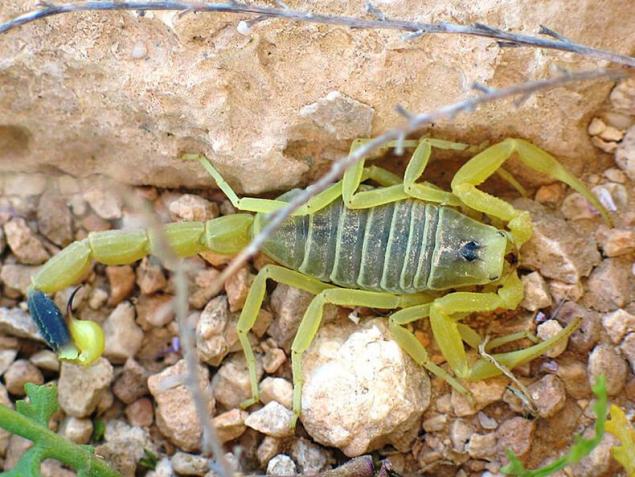
(Creeping Death, in Latin known as Leiurus quinquestriatus)
The traditional view is that increased toxicity is an attempt to compensate for the lag in other areas. Any resident of the desert will tell you that when it comes to Scorpions, the most you have to fear is not big and scary Scorpions, but small, like a Scorpion, called "Creeping Death" (deathstalker), which is considered the most dangerous Scorpion in the world.
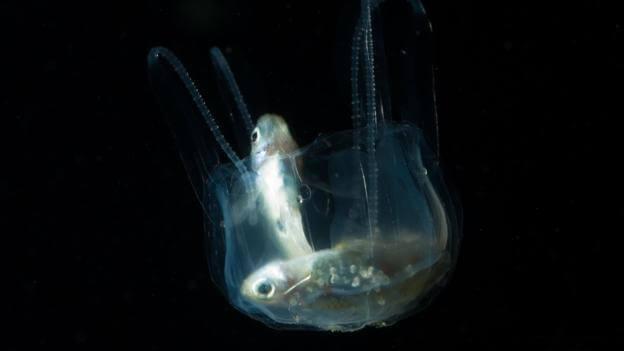
(The box jellyfish devours its victims)
"Jellyfish is also a good example," says AHU Muran (Yehu Moran, a researcher from the Hebrew University in Jerusalem, who together with his colleague Katyk Sungur (Kartik Sunagar) recently explored how natural selection acts on the toxins of venomous animals for generations.
"They are extremely fragile and something with the strength of the fish can break them from the inside when they tried to eat him. So the poison needs to be 100% effective and cause a lightning death.".
If the predator is small, frail or slow, it is vital that its poison was capable of almost instantly incapacitate the victim in order to avoid fleeing it or fighting it. In such cases, it is easy to see how the increased toxicity was natural selection.

(The inland Taipan, also known as the "fierce snake")
The economy plays a role too. The inland Taipan (inland taipan) lives in arid Central Australia where it is important that the poison caused the guaranteed and instant death. In the desert every meal can be the difference between life and death, so snake just can't afford to give his victim any chance of survival.
But even in this case, the ability to kill 250,000 mice with one bite seems to break. Wolfgan of Wust (Wolfgang Wuster), an expert on snake poisons from Bangor University in the UK, has a simple answer to the question why the Taimanov can kill 250 000 mice in one bite.
"It's because they just don't eat mice," he says. "The lethality of the venom in relation to these mice has no relation to how Taipan behaves in the wild." Although test LD50 (abbreviation for "lethal dose 50%", that is the part of the tested group should be killed to measure the strength of the poison. Testing was conducted on different types in order to find the "average hospital" the power of poison. Testing is performed not only on laboratory rats and mice, but also monkeys, cats, dogs, birds, fish and rabbits.) uses mice as the primary measure of toxicity of the venom, but this approach has disadvantages.
"This mouse model allows us to collect standard data," says Robet Harrison (Robert Harrison), "But mammals are not always included in the menu, so the force of action of the venom on mammals may not be of particular value for toxicity on amphibians, birds and arthropods." Most venomous predators are focused on some narrow and specific group of prey species and that these species affect the evolution of their venom. The result is an evolutionary arms race. View victim evolyutsioniruet in the direction of improving resistance to poison, while the type-the predator is forced to strengthen and improve your poison.
Wonder how many mice can be killed with poison one bite of Taipan, has approximately the same sense as marvel at the fact that a Cheetah can easily outrun a turtle. This is not surprising, because cheetahs hunt for animals that move much faster than turtles and turtles in turn, there is no need with all the heels run away from the cheetahs, because they are not a part of their diet.
"There is no absolute poison," says Wüst. "If You want to know how something toxic, the very first question I ask you is: Who do You want to kill.
Of course, testing the venom on mice are not completely devoid of any meaning. The purpose of these tests was to determine the potency of poisons in mammals (i.e. us), in order to gather enough information for the manufacture of antidotes.
But not all mammals are as vulnerable to poison as we are. Say mongoose, ground squirrels and even hedgehogs can survive the bites of some snakes, the venom that could easily kill a man.
"In Israel, there are kinds of mice weighing 20 g, which can survive a snake bite the carpet, whose venom would make you or me bleeding out of every orifice".
Something like this:
"I would put quite a large sum of money that somewhere in Australia there is crisise capable of withstanding the bite of a Taipan".
This Israeli super-mouse, apparently, have become so immune to the poison of the Viper, because it is her favorite dish. The paradox, but some animals are especially vulnerable to poison because of the fact that poisonous predators eat them. For example, the carpet feed primarily on Scorpions and therefore possess the poison is especially dangerous for the Scorpions.
A similar phenomenon was found in the coral snakes (coral snakes), which have the most dangerous poison for their favorite type of victim, whether fish, rodents or other snakes. In these cases, it is likely that these victims simply do not feel strong enough evolutionary pressure to evolve resistance to poison, because in their typical habitat of poisonous snakes are rare.
If they have to deal with attacks of various predators including venomous snakes make up only a small share, they will be less motivated to develop an immunity to their poison, because this pleasure is likely to be expensive and better to spend the available energy to fight the more pressing threats.
A variety of toxins also affects the evolution of venom. The more venom is composed of various components, the less likely it is that the view of the victim will be able to become immune against each toxin. Therefore, a composite poison is an evolutionary advantage and other things being equal gets more widespread than a simple poison.
In a recent article, Sunair and Muran discovered that this is true in the case of groups of animals, such as snakes and mollusks-cones (Cone snail), which became toxic relatively recently in evolutionary terms. However, some poisonous predators, such as jellyfish, spiders and millipedes, despite a much more ancient history of their poisonous have venom with fewer toxins. Looks like they passed the second stage of evolution, when natural selection has removed most of the components of the poison, leaving only a handful of the most powerful toxins.
Fortunately, none of the poisonous predators did not evolve specifically to hunt people, but there are thousands of documented cases of human deaths as a result of unsuccessful encounters with snakes, jellyfish, Scorpions and other poisonous creatures. "It looks like the primates, there is no evolutionary propensity to develop resistance to the poison," explains the Wust. So high chances that if something developed a strong poison in order to kill the victim with a strong immunity to the poison, it will easily be able to kill a man. Bad luck plays a role too.

(The Sydney funnel-shape putiny spider, also known as Atrax robustus)
A bite obtained from the Sydney funnel-shape Paulinho spider (Sydney funnel-web spider), are extremely dangerous to humans, while rodents to the poison that is relatively safe. No men or rodents, does not appear in the menu of this spider, so that its venom is so dangerous for us, is a bad combination of the features of our anatomy and the composition of its venom.
Of course, it is important to study how toxins affect human physiology. Some of these studies have allowed us to create antidotes and other drugs like captopril, which is based on the venom of a rattlesnake. However, to really understand them, we must go beyond the purely human physiology and to understand how poisons are used in nature.
We need to understand that the toxins as well as many other useful traits in the animal world, is not free. Snakes, jellyfish and molluscs-cones are not acquired powerful poisons as an end in itself. Their poisons are specialized and able to do things for which they were intended, even if that purpose is not always immediately it becomes clear.
Scientists first recorded a conversation between two dolphins, similar to a conversation between two people
The Mayans knew about the irregularity synodic period of Venus
Then in Costa Rica, our guide deftly drove that yellow-bellied sea snake back into the pool, sandwiched between the two sticks, in order to prevent less cautious passers-by from being able to accidentally step on it. I was pleased with what had just escaped the danger of dying a horrible death.
Later I discovered that my fears were unfounded. The yellow-bellied sea snake venom powerful enough to kill a man, but she has a small jaw and bad teeth, so she rarely bites anything larger than fish. And there is nothing wrong for the yellow-bellied sea snake. Fish is a common component of its menu, but people don't.published
Translation, original article
www.bbc.com/earth/story/20160404-why-some-animals-have-venoms-so-lethal-they-cannot-use-them
Source: geektimes.ru/post/279712/
My dreamy mood while walking through the beautiful Costa Rican national Park, Corcovado came to an abrupt end when the tour guide pushed a hand into my chest.
"Wait!", he shouted, pointing to something actively moving under the sand. "It's a sea serpent."

(Yellow-bellied sea snake, also known as the Pelamis platurus)
While I was watching yellow-bellied sea snake outside its native element, and obviously troubled, I remembered the fact which is learned in childhood. "Sea snake," he reminded me of my young I, " "the most dangerous of all snakes. You should be careful." .
In principle, it is true, many sea snakes and terrestrial snakes for that matter, is incredibly poisonous. In one bite Taipan snake has enough venom to kill 250,000 mice or 100 people. And this is true not only for snakes.

(Clam-cone)
One drop of poison of a mollusc cone marmoreus can kill 20 people. Jellyfish sting can cause cardiac arrest and death in a matter of minutes. This begs the question: why have a powerful weapon, capable of killing dozens of people, if you're going to use it only tete-a-tete, especially if your quarry will be on the much smaller man? It seems that supriyadi just don't make sense from an evolutionary point of view.
The reason animals have poisonous weapons in its Arsenal, is quite simple. The poison allows the predator to weaken/kill the victim, thus helping to avoid excessive risk caused by the protracted struggle with the victim. Poison is also useful for defense. However, it is surprising excessive toxicity to some organisms. Why can a snake be able to kill hundreds of thousands of mice in one bite? It looks especially strange when you consider that the poison — weapons are expensive.
Poisons usually contain a mixture of toxins are protein-based, often working as a team in order to damage internal organs being attacked. Genotoxicity snake venom can contain a single component that prevents the clotting of blood, and another component, which destroys the walls of blood vessels. The result of the action of the poison a bit predictable.
The synthesis of proteins requires considerable energy, but it did not stop the evolution of venoms contain thousands of peptides and proteins, even at great cost to the animals using them. And to some extent they themselves are aware of the price of their poison.
Such things are difficult to test directly, however, it seems that the snake is able to regulate the amount of venom injected depending on the size of their victims, so as not to waste precious venom hurl. Moreover, an experiment conducted on a rattling snakes showed 11% increase in metabolism, thereby demonstrating a link between physical strain and produce toxins.
The classical view on natural selection says that the "expensive" genes are discarded if they are not absolutely necessary for survival. And is the drop really happened in some species: so marble sea snake (Aipysurus eydouxii) after the transition to eating fish eggs have lost the ability to produce poison.
However, the fact remains that there are many animals with expensive "cocktails" of chemicals in the fangs, stings and thorns, which are much more powerful than they, apparently, need to survive. Why?

(Creeping Death, in Latin known as Leiurus quinquestriatus)
The traditional view is that increased toxicity is an attempt to compensate for the lag in other areas. Any resident of the desert will tell you that when it comes to Scorpions, the most you have to fear is not big and scary Scorpions, but small, like a Scorpion, called "Creeping Death" (deathstalker), which is considered the most dangerous Scorpion in the world.

(The box jellyfish devours its victims)
"Jellyfish is also a good example," says AHU Muran (Yehu Moran, a researcher from the Hebrew University in Jerusalem, who together with his colleague Katyk Sungur (Kartik Sunagar) recently explored how natural selection acts on the toxins of venomous animals for generations.
"They are extremely fragile and something with the strength of the fish can break them from the inside when they tried to eat him. So the poison needs to be 100% effective and cause a lightning death.".
If the predator is small, frail or slow, it is vital that its poison was capable of almost instantly incapacitate the victim in order to avoid fleeing it or fighting it. In such cases, it is easy to see how the increased toxicity was natural selection.

(The inland Taipan, also known as the "fierce snake")
The economy plays a role too. The inland Taipan (inland taipan) lives in arid Central Australia where it is important that the poison caused the guaranteed and instant death. In the desert every meal can be the difference between life and death, so snake just can't afford to give his victim any chance of survival.
But even in this case, the ability to kill 250,000 mice with one bite seems to break. Wolfgan of Wust (Wolfgang Wuster), an expert on snake poisons from Bangor University in the UK, has a simple answer to the question why the Taimanov can kill 250 000 mice in one bite.
"It's because they just don't eat mice," he says. "The lethality of the venom in relation to these mice has no relation to how Taipan behaves in the wild." Although test LD50 (abbreviation for "lethal dose 50%", that is the part of the tested group should be killed to measure the strength of the poison. Testing was conducted on different types in order to find the "average hospital" the power of poison. Testing is performed not only on laboratory rats and mice, but also monkeys, cats, dogs, birds, fish and rabbits.) uses mice as the primary measure of toxicity of the venom, but this approach has disadvantages.
"This mouse model allows us to collect standard data," says Robet Harrison (Robert Harrison), "But mammals are not always included in the menu, so the force of action of the venom on mammals may not be of particular value for toxicity on amphibians, birds and arthropods." Most venomous predators are focused on some narrow and specific group of prey species and that these species affect the evolution of their venom. The result is an evolutionary arms race. View victim evolyutsioniruet in the direction of improving resistance to poison, while the type-the predator is forced to strengthen and improve your poison.
Wonder how many mice can be killed with poison one bite of Taipan, has approximately the same sense as marvel at the fact that a Cheetah can easily outrun a turtle. This is not surprising, because cheetahs hunt for animals that move much faster than turtles and turtles in turn, there is no need with all the heels run away from the cheetahs, because they are not a part of their diet.
"There is no absolute poison," says Wüst. "If You want to know how something toxic, the very first question I ask you is: Who do You want to kill.
Of course, testing the venom on mice are not completely devoid of any meaning. The purpose of these tests was to determine the potency of poisons in mammals (i.e. us), in order to gather enough information for the manufacture of antidotes.
But not all mammals are as vulnerable to poison as we are. Say mongoose, ground squirrels and even hedgehogs can survive the bites of some snakes, the venom that could easily kill a man.
"In Israel, there are kinds of mice weighing 20 g, which can survive a snake bite the carpet, whose venom would make you or me bleeding out of every orifice".
Something like this:
"I would put quite a large sum of money that somewhere in Australia there is crisise capable of withstanding the bite of a Taipan".
This Israeli super-mouse, apparently, have become so immune to the poison of the Viper, because it is her favorite dish. The paradox, but some animals are especially vulnerable to poison because of the fact that poisonous predators eat them. For example, the carpet feed primarily on Scorpions and therefore possess the poison is especially dangerous for the Scorpions.
A similar phenomenon was found in the coral snakes (coral snakes), which have the most dangerous poison for their favorite type of victim, whether fish, rodents or other snakes. In these cases, it is likely that these victims simply do not feel strong enough evolutionary pressure to evolve resistance to poison, because in their typical habitat of poisonous snakes are rare.
If they have to deal with attacks of various predators including venomous snakes make up only a small share, they will be less motivated to develop an immunity to their poison, because this pleasure is likely to be expensive and better to spend the available energy to fight the more pressing threats.
A variety of toxins also affects the evolution of venom. The more venom is composed of various components, the less likely it is that the view of the victim will be able to become immune against each toxin. Therefore, a composite poison is an evolutionary advantage and other things being equal gets more widespread than a simple poison.
In a recent article, Sunair and Muran discovered that this is true in the case of groups of animals, such as snakes and mollusks-cones (Cone snail), which became toxic relatively recently in evolutionary terms. However, some poisonous predators, such as jellyfish, spiders and millipedes, despite a much more ancient history of their poisonous have venom with fewer toxins. Looks like they passed the second stage of evolution, when natural selection has removed most of the components of the poison, leaving only a handful of the most powerful toxins.
Fortunately, none of the poisonous predators did not evolve specifically to hunt people, but there are thousands of documented cases of human deaths as a result of unsuccessful encounters with snakes, jellyfish, Scorpions and other poisonous creatures. "It looks like the primates, there is no evolutionary propensity to develop resistance to the poison," explains the Wust. So high chances that if something developed a strong poison in order to kill the victim with a strong immunity to the poison, it will easily be able to kill a man. Bad luck plays a role too.

(The Sydney funnel-shape putiny spider, also known as Atrax robustus)
A bite obtained from the Sydney funnel-shape Paulinho spider (Sydney funnel-web spider), are extremely dangerous to humans, while rodents to the poison that is relatively safe. No men or rodents, does not appear in the menu of this spider, so that its venom is so dangerous for us, is a bad combination of the features of our anatomy and the composition of its venom.
Of course, it is important to study how toxins affect human physiology. Some of these studies have allowed us to create antidotes and other drugs like captopril, which is based on the venom of a rattlesnake. However, to really understand them, we must go beyond the purely human physiology and to understand how poisons are used in nature.
We need to understand that the toxins as well as many other useful traits in the animal world, is not free. Snakes, jellyfish and molluscs-cones are not acquired powerful poisons as an end in itself. Their poisons are specialized and able to do things for which they were intended, even if that purpose is not always immediately it becomes clear.
Scientists first recorded a conversation between two dolphins, similar to a conversation between two people
The Mayans knew about the irregularity synodic period of Venus
Then in Costa Rica, our guide deftly drove that yellow-bellied sea snake back into the pool, sandwiched between the two sticks, in order to prevent less cautious passers-by from being able to accidentally step on it. I was pleased with what had just escaped the danger of dying a horrible death.
Later I discovered that my fears were unfounded. The yellow-bellied sea snake venom powerful enough to kill a man, but she has a small jaw and bad teeth, so she rarely bites anything larger than fish. And there is nothing wrong for the yellow-bellied sea snake. Fish is a common component of its menu, but people don't.published
Translation, original article
www.bbc.com/earth/story/20160404-why-some-animals-have-venoms-so-lethal-they-cannot-use-them
Source: geektimes.ru/post/279712/
This plant treats osteochondrosis, arthritis, arthrosis and irreplaceable with diabetes
Causes of cellulite: what you need to know


